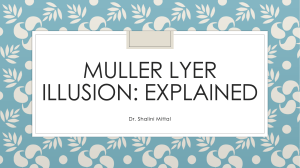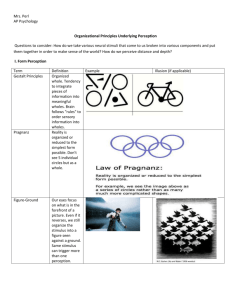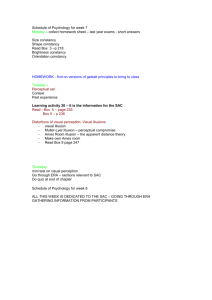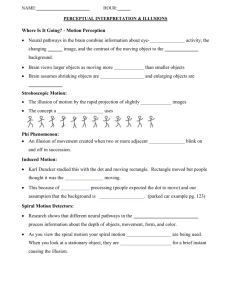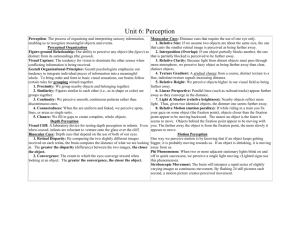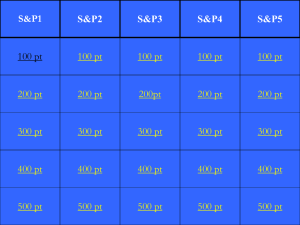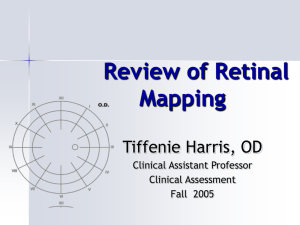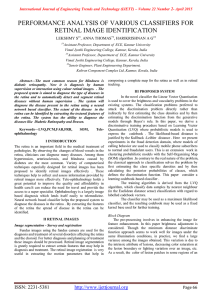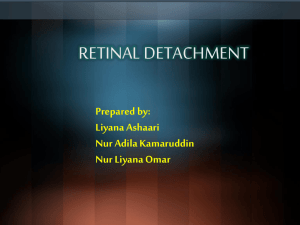Answers
advertisement
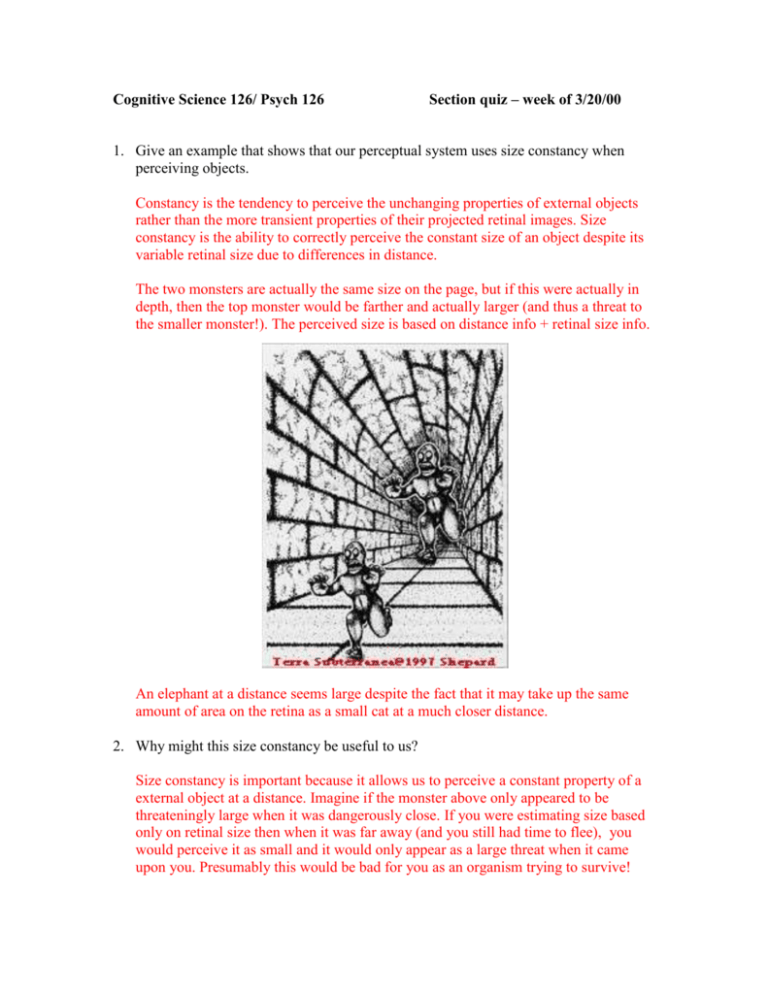
Cognitive Science 126/ Psych 126 Section quiz – week of 3/20/00 1. Give an example that shows that our perceptual system uses size constancy when perceiving objects. Constancy is the tendency to perceive the unchanging properties of external objects rather than the more transient properties of their projected retinal images. Size constancy is the ability to correctly perceive the constant size of an object despite its variable retinal size due to differences in distance. The two monsters are actually the same size on the page, but if this were actually in depth, then the top monster would be farther and actually larger (and thus a threat to the smaller monster!). The perceived size is based on distance info + retinal size info. An elephant at a distance seems large despite the fact that it may take up the same amount of area on the retina as a small cat at a much closer distance. 2. Why might this size constancy be useful to us? Size constancy is important because it allows us to perceive a constant property of a external object at a distance. Imagine if the monster above only appeared to be threateningly large when it was dangerously close. If you were estimating size based only on retinal size then when it was far away (and you still had time to flee), you would perceive it as small and it would only appear as a large threat when it came upon you. Presumably this would be bad for you as an organism trying to survive! 3. Describe what the size-distance relation is (h = 2d * tan (a/2)) and how it relates to Emmert’s Law. The size-distance relation is a simple concept that relates the size of an image on the retina to its distance on the retina. A good illustration of the formula in action can be found in Figure 7.1.1. Basically, the calculation involves some trigonometry that allows you to calculate the length of one side of a right triangle given an angle (1/2 the visual angle of the stimulus on the retina) and the distance from the observer to the object. Emmert's Law states that the perceived size of a constant retinal image is proportional to its perceived distance (which may differ from its actual distance). The Moon Illusion is a good example of how a retinal image of the same size can appear to be different sizes based on differences in the perceived distance of the object. When the moon is near the horizon it appears to be farther. If it were indeed farther than the moon high in the sky, it would need to be larger to cast a retinal image of the same size of the one high in the sky. In order to cast the same size retinal image at a farther distance, the moon would have to be larger. You can work this out with the sizedistance relation. 4. Give an example of an illusion of a)shape and b)orientation: Shape Illusions: The Shepard Illusion - Figure 7.2.7 Ames Room - http://www.illusionworks.com/html/ames_room.html Orientation Illusions: Zllner Illusion - Figure 7.3.5 Café Wall Illusion - Interactive Demo http://www.illusionworks.com/html/cafe_wall.html Tilted Room - Figure 7.3.3 5. Where do we get information about orientation with respect to gravity? Information about orientation with respect to gravity primarily comes from the proprioceptive system. The vestibular system is the main organ of balance. It is found in the middle ear and is composed of the semicircular canals and the utricle and saccule. These fluid-filled sacs contain heavy particles that influence the bending of special cell hairs. The amount of bending of these hairs gives information about the orientation of the head in the environment. 6. Distinguish between the afferent theory and the efferent copy theory of position constancy during eye movements. The afferent theory states that feedback information about the tension of eye muscles is sent back to the visual system in order to provide information about the positions of the eyes and eye movements. The efferent theory states that the visual system gets a copy of the commands that are sent to the eye to perform eye movements. These commands can be used to determine the positions and movements of the eyes. How might one test these theories empirically? 7. What is visual capture? Visual capture is a phenomenon in which vision dominates other sensory modalities when they are in conflict about the properties of objects. This seems to give some demonstration to how adaptive the whole system is to managing conflicting inputs. 8. What is global precedence? How does it seem to be related to cerebral hemispheres? Describe how a person with left or right hemisphere damage might perceive the following drawing: Y Y EY E S E S Y S Y E Y E S E S Y S Y E YE S ES YESYESYES Y Y E E S S Y Y E E S S Y Y YESYESYES Global precedence is the notion that in hierarchical patterns like those shown above, the global percept (in this case "no") is perceived first. Because of this, it is predicted that (1) Responses to the global configuration (does the global configuration show "yes" or "no"?) should be faster than that to the local configuration. (2) There should be global-to-local interference. That is, when asked to identify the local patterns, there should be interference from the global pattern if it is inconsistent. (3) No localto-global interference. Neuropsychological evidence has made some dissociation between the hemisphere for global and local processing. Patients with right hemisphere damage seem to have some difficulty with perceiving the global aspects of stimuli like the one above. If asked to draw the above figures they would probably reproduce many of the "YES" words. However, these "yes" words would probably not be organized into the global "N" and "O". Left-hemisphere patients seem to have the opposite problem. Such patients have a difficult time identifying the local information in the stimulus. They may only be able to report the global pattern in the stimulus. Examples of drawing made by the two types of patients can be found in Figure 7.6.11.
